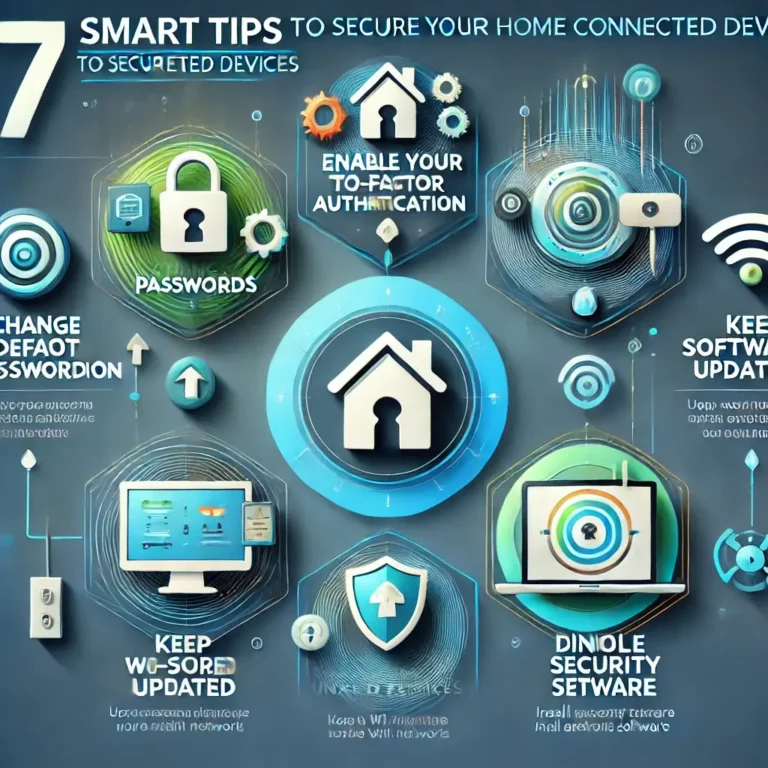The convenience of connected devices in modern homes is undeniable. From smart TVs to voice assistants, these gadgets make life easier. However, they also introduce vulnerabilities to cyber threats. Protecting your devices isn’t just about safeguarding personal data—it’s about preserving your peace of mind. Ready to fortify your smart home? Let’s dive into actionable tips to keep your devices safe.
Table of Contents
1. Keep Software and Firmware Updated
One of the simplest yet most overlooked security measures is updating your devices’ software and firmware. Manufacturers often release updates to patch vulnerabilities discovered after launch.
- Why it matters: Outdated devices are more susceptible to cyberattacks. Hackers often exploit known flaws in older systems.
- Action step: Enable automatic updates whenever possible to ensure your devices are always protected.
Take a practical example: A smart thermostat may have a software update that improves encryption. Without updating, your home temperature data—and potentially access to your network—could be at risk.
2. Use Strong, Unique Passwords
Default passwords are a hacker’s playground. Weak or reused passwords make it easier for attackers to infiltrate your network.
- Pro tip: Use a password manager to generate and store complex passwords for each device.
- Bonus: Change passwords every few months for added security.
For instance, instead of a password like “123456,” opt for something more complex, such as “Xy$8@2zKl!.” While this might seem tedious, tools like LastPass or 1Password can handle the heavy lifting.
3. Secure Your Wi-Fi Network
Your home network acts as the gateway to all connected devices. If it’s not secure, your devices are at risk.

- How to secure it:
- Change the default router login credentials immediately after setup.
- Enable WPA3 encryption, the latest and most secure standard.
- Hide your network name (SSID) to make it less visible to outsiders.
Additionally, consider setting up a guest network for visitors. This keeps your primary network isolated, adding another layer of protection.
4. Enable Multi-Factor Authentication (MFA)
Whenever possible, enable MFA on accounts linked to your connected devices. This extra layer of security makes it significantly harder for hackers to gain access.
- What it adds: Even if someone guesses your password, they’ll still need a secondary verification method, such as a code sent to your phone.
Think about your smart home hub. Without MFA, anyone with access to your credentials could control your lighting, cameras, or even door locks. MFA makes this scenario virtually impossible.
5. Disable Unused Features and Devices
Not every feature or device in your home needs to be active all the time. Leaving them on increases the attack surface for potential threats.
- For example: If you’re not using remote access or voice control, turn it off.
- Why it’s important: Fewer active features mean fewer vulnerabilities.
Smart TVs, for instance, often come with built-in cameras or microphones. If you’re not using these features, disabling them reduces the risk of unauthorized access.
6. Invest in a Smart Firewall
Traditional routers provide basic protection, but a smart firewall offers advanced security tailored for connected homes.
- What it does: Monitors traffic, blocks suspicious activities, and protects all devices connected to your network.
- Best practice: Pair it with antivirus software for comprehensive coverage.
Products like Bitdefender Box or Norton Core are excellent choices, as they’re specifically designed to secure IoT ecosystems.
7. Educate Your Household Members
All the security measures in the world won’t help if the people in your home aren’t informed about safe practices.
- Tips to share:
- Avoid clicking on suspicious links, especially in emails or texts claiming to be from device manufacturers.
- Regularly check devices for signs of tampering, such as unusual behavior or settings changes.
- Report unusual activity immediately, whether it’s a lagging device or an unexpected connection.
Teaching kids or less tech-savvy family members about cyber hygiene can prevent unintentional security breaches.
Why Securing Connected Devices Is More Important Than Ever
With the rise of smart homes, hackers are becoming more sophisticated. Protecting your connected devices ensures not just your privacy but also the integrity of your home. Imagine a scenario where a hacked camera compromises your family’s security—this is why vigilance matters.
Take another example: A smart lock breach doesn’t just threaten physical safety but can also lead to stolen data.
Conclusion
Securing your connected devices may seem overwhelming, but following these steps ensures a safer digital environment. Regular updates, strong passwords, and educating your household go a long way in reducing risks.
By taking proactive measures, you’re not just protecting gadgets—you’re safeguarding your family and personal information. Remember, a secure smart home is a happy home. Invest in your safety today, and enjoy the conveniences of modern technology without compromise.








